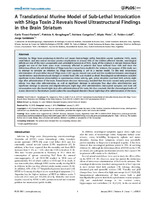Please use this identifier to cite or link to this item:
http://sgc.anlis.gob.ar/handle/123456789/487| Title: | A translational murine model of sub-lethal intoxication with shiga toxin 2 reveals novel ultrastructural findings in the brain striatum | Authors: | Tironi-Farinati, Carla Geoghegan, Patricia A. Cangelosi, Adriana Pinto, Alipio Loidl, C. Fabian Goldstein, Jorge |
Keywords: | Escherichia coli;Síndrome Hemolítico-Urémico;Manifestaciones Neurológicas;Toxina Shiga II | Issue Date: | Jan-2013 | Project: | datasets | Abstract: | Infection by Shiga toxin-producing Escherichia coli causes hemorrhagic colitis, hemolytic uremic syndrome (HUS), acute renal failure, and also central nervous system complications in around 30% of the children affected. Besides, neurological deficits are one of the most unrepairable and untreatable outcomes of HUS. Study of the striatum is relevant because basal ganglia are one of the brain areas most commonly affected in patients that have suffered from HUS and since the deleterious effects of a sub-lethal dose of Shiga toxin have never been studied in the striatum, the purpose of this study was to attempt to simulate an infection by Shiga toxin-producing E. coli in a murine model. To this end, intravenous administration of a sub-lethal dose of Shiga toxin 2 (0.5 ηg per mouse) was used and the correlation between neurological manifestations and ultrastructural changes in striatal brain cells was studied in detail. Neurological manifestations included significant motor behavior abnormalities in spontaneous motor activity, gait, pelvic elevation and hind limb activity eight days after administration of the toxin. Transmission electron microscopy revealed that the toxin caused early perivascular edema two days after administration, as well as significant damage in astrocytes four days after administration and significant damage in neurons and oligodendrocytes eight days after administration. Interrupted synapses and mast cell extravasation were also found eight days after administration of the toxin. We thus conclude that the chronological order of events observed in the striatum could explain the neurological disorders found eight days after administration of the toxin. |
Description: | Fil: Tironi-Farinati, Carla. Universidad de Buenos Aires. Facultad de Medicina. Departamento de Fisiología. Laboratorio de Neurofisiopatologia; Argentina. Fil: Geoghegan, Patricia A. ANLIS Dr. C. G. Malbrán. Centro Nacional de Control de Calidad de Biológicos (CNCCB); Argentina. Fil: Cangelosi, Adriana. ANLIS Dr. C. G. Malbrán. Centro Nacional de Control de Calidad de Biológicos (CNCCB); Argentina. Fil: Pinto, Alipino. Universidad de Buenos Aires. Facultad de Medicina. Departamento de Fisiología. Laboratorio de Neurofisiopatologia; Argentina. Fil: Loidl, Fabian C. Universidad de Buenos Aires. Facultad de Medicina. Instituto de Biología Celular y Neurociencia "Prof. E. De Robertis"; Argentina. Fil: Goldstein, Jorge. Universidad de Buenos Aires. Facultad de Medicina. Departamento de Fisiología. Laboratorio de Neurofisiopatologia; Argentina. |
URI: | http://sgc.anlis.gob.ar/handle/123456789/487 | DOI: | https://doi.org/10.1371/journal.pone.0055812 | Rights: | Open Access Creative Commons Attribution 4.0 International License |
| Appears in Collections: | Preproducción Publicaciones CNCCB |
Files in This Item:
| File | Description | Size | Format | |
|---|---|---|---|---|
| PLoSONE,2013,8(1),e55812..pdf | 1.92 MB | Adobe PDF |  View/Open |
Page view(s)
177
checked on Dec 24, 2025
Download(s)
25
checked on Dec 24, 2025
Google ScholarTM
Check
Altmetric
Altmetric
This item is licensed under a Creative Commons License


